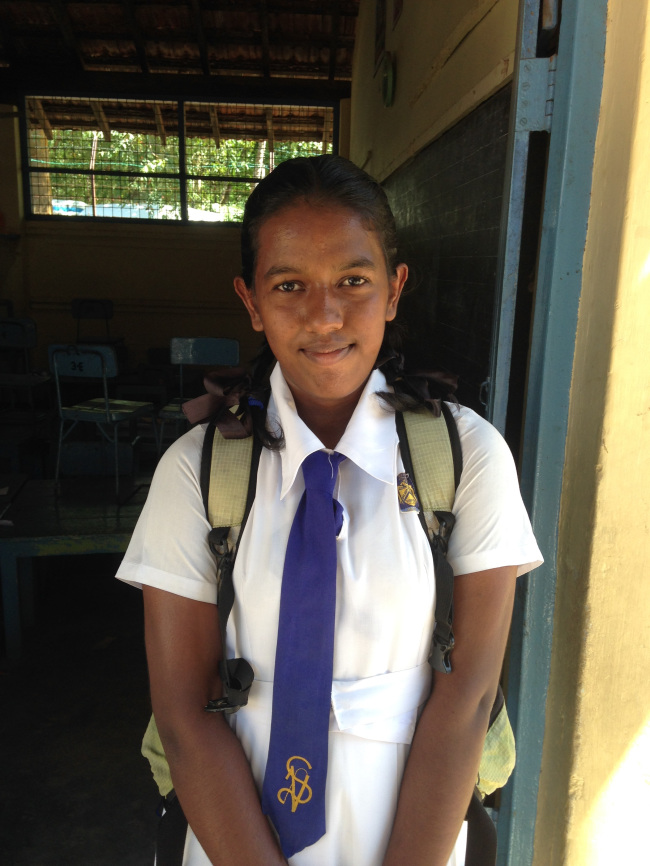KOICA committed to improving health care, education in Sri Lanka
By Shin Hyon-heePublished : Dec. 14, 2014 - 22:44
MATARA/COLOMBO, Sri Lanka -- Only five years ago, Pavani Punsara Weerasekera, an 18-year-old student at Sujatha College, was seen walking along an all-too-familiar path that would have never set her apart from many of her peers living on low incomes and life chances.
But an encounter with a volunteer from the Korea International Cooperation Agency helped her discover her knack for languages and improved her job prospects. As she develops her fluency in Korean, her dream of studying in Seoul and becoming a teacher in her tsunami-hit hometown inches closer to becoming a reality.
A fan of Korean pancakes, she won a gold medal in a Korean speech contest hosted by the state aid agency’s Sri Lanka office in June 2013 and visited Seoul two months later. She has now given herself a Korean name, Soon-ja.
“At first I just happened to have started learning Korean but it became more fun, although difficult,” Weerasekera said.
“I grew fonder of Korea and learning the language after visiting. I wish to go to college in Korea and become a good Korean teacher when I come back, just like those who taught me.”
But an encounter with a volunteer from the Korea International Cooperation Agency helped her discover her knack for languages and improved her job prospects. As she develops her fluency in Korean, her dream of studying in Seoul and becoming a teacher in her tsunami-hit hometown inches closer to becoming a reality.
A fan of Korean pancakes, she won a gold medal in a Korean speech contest hosted by the state aid agency’s Sri Lanka office in June 2013 and visited Seoul two months later. She has now given herself a Korean name, Soon-ja.
“At first I just happened to have started learning Korean but it became more fun, although difficult,” Weerasekera said.
“I grew fonder of Korea and learning the language after visiting. I wish to go to college in Korea and become a good Korean teacher when I come back, just like those who taught me.”

Weerasekera’s case is one of the success stories that KOICA is seeking to foster at Sujatha Vidyalaya, a girls’ elementary school in the southernmost city of Matara, and elsewhere in Sri Lanka.
Seventy-six volunteers are dispatched throughout Sri Lanka, teaching Korean, computer skills, sports, arts and other subjects.
When the Korea Herald visited the school recently, a number of volunteers were planting grass, painting murals in the playground and distributing food.
“People here maintain a pure heart in the face of their hectic, hardscrabble lives,” Kim Bong-hwi, a 62-year-old volunteer in charge of poetry and computer education, told The Korea Herald. He came to the coastal province in March after ending his 30-odd year teaching career at a high school in Busan.
“Teachers are very much honored here, though their monthly pay stands only at about 18,000 Sri Lankan rupees ($137). I enjoy my days here despite many difficulties and hardships.”
Currently, KOICA is carrying out projects in about 11 areas including infrastructure, vocational training and environmental improvement.
Education is one of the priorities for the institution, as Colombo is stepping up efforts to shake off the impact of its 25-year civil war and the 2004 earthquake and tsunami.
It has channeled $5 million over the last three years into building 12 primary and middle schools across the battle-stricken town of Kilinochchi, some 350 km north of the capital, to provide education opportunities for more than 6,600 students. Teachers and officials also received relevant training.
With a focus on information and communications technology, Sri Lanka is working to install 1,000 labs around the country and nurture instructors. KOICA, for its part, plans to launch a project next year to train technology teachers, devise curricula and eventually help set up specialized academic institutions by 2019 in partnership with international bodies like the U.N. Educational, Scientific and Cultural Organization and Asian Development Bank.
“Just like Sri Lanka, Korea had gone through a war and other numerous difficulties. But it worked hard and achieved substantial development,” Sri Lankan Education Minister Bandula Gunawardena said in an interview with visiting Korean journalists.
“We’re striving to offer equal opportunities to students in all regions and Korea offered significant assistance in establishing schools in the North. … (The new project) will also benefit our education program.”
With medical care being another major focus, KOICA launched a hospital with 260 sickbeds also in Matara in 2011 as part of its efforts to support the city’s post-disaster reconstruction. The 2004 tsunami killed at least 30,000 throughout the island country. The Kyung Hee University Healthcare System is currently carrying out maintenance.
In another public-private partnership project, the institution set up an acupuncture clinic in 2004 in Colombo to help transfer Korean traditional medicine and create synergy with that of Sri Lanka.
On an ordinary weekday morning, the hospital was packed, with around 50 people waiting for their turn.

Member doctors of the Korean Medicine Service Team Abroad, a Seoul-based nonprofit association, perform acupuncture on more than 150 patients every day here, while running a traveling clinic about four times a year.
At least 175 local practitioners have completed training over the last 10 years and another 52 are receiving education, according to Kim In-gyu, an oriental doctor who works at the hospital as part of KOICA’s World Friends Korea Advisors program.
“Sri Lankans prefer Korean medicine because compared with other methods they can treat diseases without many side effects,” Pearl Weerasinghe, secretary at the Sri Lankan Ministry of Indigenous Medicine.
“Given our own traditional medicine’s 3,000-year history, western medicine came relatively recently. There is even an increasing trend that Western physicians are coming back to Oriental medicine.”
By Shin Hyon-hee, Korea Herald correspondent
(heeshin@heraldcorp.com)







![[Hello India] Hyundai Motor vows to boost 'clean mobility' in India](http://res.heraldm.com/phpwas/restmb_idxmake.php?idx=644&simg=/content/image/2024/04/25/20240425050672_0.jpg&u=)










